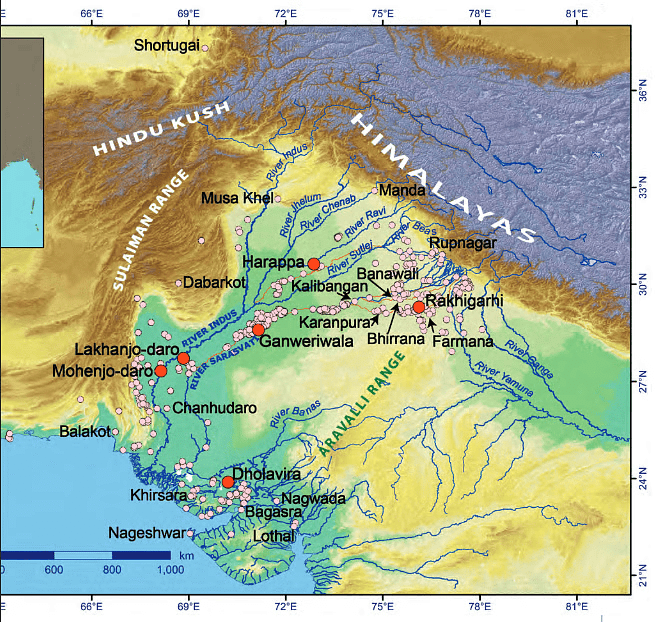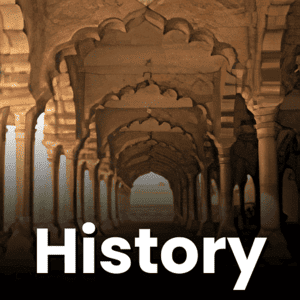The Beginnings of Indian Civilisation NCERT Solutions | Social Studies (SST) Class 6 PDF Download
| Table of contents |

|
| Questions, Activities and Projects |

|
| The Big Questions |

|
| Page 87 |

|
| Page 93 |

|
| Think About It |

|
Questions, Activities and Projects
Q1. Why does the civilisation studied in this chapter have several names? Discuss their significance.
Ans: The civilization has multiple names, including Harappan, Indus, and Indus-Sarasvatī.
Each name highlights different features:
- Harappan: Derived from Harappa, the first site excavated in the 1920s.
- Indus: Named after the Indus River, vital for the civilization's development.
- Indus-Sarasvatī: Reflects the importance of the Sarasvatī River in agriculture and trade.
Q2. Write a brief report (150 to 200 words) summing up some of the achievements of the Indus-Sarasvatī civilisation.
Ans: The Indus-Sarasvatī Civilization is renowned for its remarkable achievements:
- Planned Cities: The Harappans built cities with sophisticated drainage systems, showcasing their focus on sanitation.
- Trade: They developed a strong trade network with Mesopotamia, using standardised weights and measures.
- Artistry: The civilization was skilled in bead-making and pottery, creating intricate artefacts that highlight their artistic talent.
- Administration: They kept records and established governance to effectively manage urban life and trade.
Q3. Imagine you have to travel from the city of Harappa to Kalibangan. What are your different options? Can you make a rough estimation of the amount of time each option might take?
Ans: To travel from Harappa to Kalibangan in ancient times, you had several options:
- Indus River: A safe and efficient way to travel by water.
- Overland Travel: After reaching the river, you could continue by horseback, bullock cart, or on foot.
The distance is about 200 kilometres, and the journey could take a few days, depending on conditions and speed.
Q4. Let us imagine a Harappan man or woman being transported to an average kitchen in today’s India. What are the four or five biggest surprises awaiting them?
Ans: A Harappan individual in a modern kitchen would be surprised by:
- The availability of electrical appliances, such as refrigerators and microwaves.
- The wide range of processed and packaged foods, along with running water from taps.
- The use of gas or electric stoves instead of traditional firewood.
- Modern utensils and cookware, particularly stainless steel and non-stick materials.
Q5. Looking at all the pictures in this chapter, make a list of the ornaments / gestures / objects that still feel familiar in our 21st century.
Ans: Familiar ornaments, gestures, and objects in the 21st century include:
- Bangles and beads
- The ‘namaste’ gesture
- Mirrors and toys
Q6. What mindset does the system of reservoirs at Dholavira reflect?
Ans: The system of reservoirs at Dholavira reflects a mindset characterised by:
- Advanced Planning: The construction of large, interconnected reservoirs showcases the Harappans' ability to plan and execute complex engineering projects.
- Water Conservation: The presence of multiple reservoirs highlights their understanding of the need to conserve water in an arid environment.
- Social Organisation: The coordinated effort to build and maintain these reservoirs indicates a well-organised society that prioritizes public welfare.
- Sustainability: Their efficient water harvesting and distribution systems reflect foresight in creating sustainable living conditions for future generations.
Q7. In Mohenjo-daro, about 700 wells built with bricks have been counted. They seem to have been regularly maintained and used for several centuries. Discuss the implications.
Ans: The discovery of 700 brick wells in Mohenjo-daro suggests several important implications:
- Sophisticated Urban Planning: Indicates advanced planning and a decentralised water supply system.
- Reliable Water Supply: Ensures all residents had access to water, essential for urban living.
- Well-Organised Governance: Regular maintenance points to a stable administration managing public utilities.
- Social Stability: Long-term upkeep reflects a stable society with effective governance.
- Commitment to Public Welfare: Availability of wells demonstrates a strong focus on public health and access to clean water.
Q8. It is often said that the Harappans had a high civic sense. Discuss the significance of this statement. Do you agree with it? Compare with citizens in a large city of India today.
Ans: The Harappan cities were well-planned, featuring:
- Organised Layout: Wide streets and a systematic drainage system, indicating a commitment to urban living.
- Uniform Housing: Similar quality homes suggest a focus on fairness and community support.
- Public Health: Effective drainage systems prioritised sanitation and health.
Comparison with Modern Indian Cities:
- Similar Challenges: Both face issues like water supply, waste management, and public health.
- Varying Civic Responsibility: Some modern cities demonstrate high civic responsibility, while others struggle with pollution and waste disposal.
- Historical Benchmark: The Harappans set a standard for urban planning and civic duty that modern cities can aspire to.
The Big Questions
Q1. What is a civilisation?
Ans: A civilisation is a complex stage of human society characterised by:
- Government and administration to manage societal activities.
- Urbanism involving town planning and city management, including water systems.
- A variety of crafts that utilise raw materials to create goods.
- Trade both within regions and with distant areas.
- A system of writing for record-keeping and communication.
- Cultural ideas are expressed through art, architecture, and social customs.
- Agriculture that supports both villages and cities.
Q2. What was the earliest civilisation of the Indian Subcontinent?
Ans: The earliest known civilisation of the Indian subcontinent is the Indus Valley Civilisation, also referred to as the Harappan Civilisation.
- It emerged around 2600 BCE.
- Located in the fertile plains of the Indus River and its tributaries.
- Known for its well-planned cities and advanced urban infrastructure.
- Inhabitants are called Harappans, named after the city of Harappa, the first site excavated.
Q3. What were its major achievements?
Ans: The Harappan Civilisation made significant advancements for its time. Here are some of their major achievements:
- Urban Planning: They built well-planned cities featuring grid layouts, drainage systems, and sanitation facilities.
- Advanced Architecture: The use of fired bricks allowed for multi-storied buildings and impressive granaries.
- Craft and Technology: They excelled in metalworking, pottery, and seal carving, and developed a system of weights and measures.
- Trade: An extensive trade network connected them with Mesopotamia and other regions, with evidence of traded goods like beads and tools.
- Writing System: They created a writing system, though its complete understanding is still a work in progress.
 |
Test: The Beginnings of Indian Civilisation - 1
|
Start Test |
Page 87
Q1. For each characteristic in the list above, can you make a list of professions or occupations that might exist in such a society?
Ans: The list of professions or occupations for each characteristic of a civilisation mentioned:
- Government and Administration: Ruler/King/Queen, Governors, Tax Collectors, Judges, Scribes, Military Leaders, Advisers and Bureaucrats.
- Urbanism (Town-Planning, Growth of Cities, Water Management, Drainage System): Architects, City Planners, Engineers, Builders/Construction Workers, Water Management Specialists, Sanitation Workers, Surveyors and Brick makers.
- Variety of Crafts (Management of Raw Materials, Production of Finished Goods): Blacksmiths, Potters, Weavers, Carpenters, Jewellers, Stone Masons, Metalworkers and Leatherworkers.
- Trade (Internal and External): Merchants, Traders, Shipbuilders, Caravaneers, Market Vendors, Moneylenders, Warehouse Managers and Sailors.
- Writing (Record-Keeping, Communication): Scribes, Record Keepers, Librarians, Teachers, Calligraphers, Clerks, Historians and Archivists.
- Cultural Ideas (Art, Architecture, Literature, Oral Traditions, Social Customs): Artists, Architects, Sculptors, Poets, Musicians, Storytellers, Priests/ Religious Leaders and Actors.
- Productive Agriculture: Farmers, Herders, Fishermen, Irrigation Specialists, Seed Collectors, Agricultural Tool Makers, Animal Breeders and Market Gardeners.
Page 93
Q1. Have a debate in class about the last two interpretations. Can you think of any others? Remember that in this case, we do not have any other source of history — no inscription, no text, no traveller's account.
Ans: Debate on the Interpretations of the Great Bath's Purpose
- Interpretation 1: Bath for the Royal Family Only
- Pros:
- The elaborate design suggests it may have been for a privileged group.
- Its central location indicates its importance.
- Adjacent rooms could imply private use.
- Cons:
- No direct evidence of social stratification in Harappan society.
- Pros:
Q2. Looking at the three Harappan seals with some writing signs, what goes through your mind? Would you like to suggest any interpretations? Let your imagination run!
Ans: Looking at the three Harappan seals, several interpretations arise:
- Unicorn Seal: This may represent a clan or deity, symbolising purity or power in Harappan society.
- Bull Seal: Likely significant for agriculture, this seal could mark goods or property, indicating strength or fertility.
- Horned Tiger Seal: This may signify safety or combat skills, possibly used by soldiers or in ceremonies to denote power.
Imaginative interpretations include:
- Communication Tools: Early forms of ID cards or business logos.
- Religious Symbols: Representations of gods or spirits for rituals.
- Trade Marks: Used to certify the origin and quality of goods in trade.
Q3. Complete the story found on the Lothal pot. How was such a story remembered for more than 4,000 years, in your opinion?
Ans: Completing the Story on the Lothal Pot
The story depicted on the Lothal pot features a thirsty crow that discovers a pot with a small amount of water at the bottom. Unable to reach the water, the clever crow drops pebbles into the pot. As the water level rises, the crow is finally able to drink to its fill.
Such stories have likely been remembered for over 4,000 years through:
- Oral traditions where tales were shared verbally across generations.
- Storytelling that engaged listeners and made the lessons memorable.
- Inscriptions or symbols on everyday items, like pottery, that conveyed these narratives.
 |
Download the notes
NCERT Solutions: The Beginnings of Indian Civilisation
|
Download as PDF |
Think About It
Q1. Consider the 'Dancing Girl' figurine. What do you make of the attitude the figurine expresses? Observe her bangles covering an entire arm, a practice still visible in parts of Gujarat and Rajasthan. Where else in this chapter can you spot bangles worn in this manner? What conclusion should we draw from this?
Ans: Attitude Expressed by the 'Dancing Girl': The 'Dancing Girl' figurine shows confidence and grace. Her pose, with one hand on her hip and the other relaxed, suggests a carefree and possibly celebratory attitude. The intricate details highlight the significance of dance and artistic expression in Harappan culture.
Bangles in the Chapter: Similar bangles can be seen in other artifacts and illustrations throughout the chapter. The depiction of bangles covering an entire arm indicates that this practice was common in Harappan society. This ornamentation tradition has continued for thousands of years, showcasing the enduring customs of jewelry in the region. Today, this practice is still evident in parts of Gujarat and Rajasthan, reflecting the lasting influence of ancient Harappan culture on modern India.
Q2. Which of the above characteristics do you think is the most fundamental — that is, a characteristic essential to the development of all others?
Ans: Each characteristic plays a vital role, but productive agriculture is arguably the most fundamental.
This is because:
- A stable food supply is essential for the survival and growth of a population.
- Once basic needs are met, societies can develop other aspects such as government, urbanism, crafts, trade, writing, and cultural ideas.
- Without productive agriculture, supporting large populations for complex societal development becomes challenging.
Q3. You may have come across the term 'Indus Valley civilisation' and noticed that we have not used it. A look at the map (Fig. 6.3 on page 89) explains why the term 'Valley' is obsolete, as we now know that the civilisation extended much beyond the Indus region.

Ans: The term “Indus Valley civilisation” is commonly used to describe the ancient civilisation that developed around the Indus River. However, this term is now seen as obsolete because the civilisation's influence extended well beyond the valley itself.
- The civilisation covered a vast area, including parts of present-day India, Pakistan, and beyond.
- Referring to it as the “Indus region” better represents its true geographical extent.
- Archaeologists have identified various names for this civilisation, such as “Harappan” and “Indus-Sarasvati”.
- The inhabitants are known as “Harappans”, named after the city of Harappa, which was the first site excavated in the early 1920s.
Q4. As a class activity, measure the length of your classroom, a school corridor or a playground with the help of any measuring tape. Compare these lengths with the length of the largest reservoir in Dholavira.
Ans: For this activity, follow these steps:
- Measure the Length: Use a measuring tape to measure the length of your classroom, corridor, or playground. Record the measurement in metres.
- Find the Reservoir Length: The largest reservoir in Dholavira is approximately 79 metres long.
- Compare the Lengths: Compare your measurement with the 79-metre reservoir. Discuss whether your measured space is longer or shorter. For example, if your classroom is 10 metres long, it would take about 8 classrooms to equal the reservoir's length.
Q5. Imagine the large number of workers required to build such a network of reservoirs. Who do you think organised their work and gave them precise instructions? How do you think they were paid for their labour? (Hint: there was no money at that time in the way we have today.) Since the reservoirs needed to be cleaned from time to time, was there some local authority to manage their maintenance? What clues do we get from all this about this city's ruler and municipal administration? Use your imagination and discuss with your teacher. Archaeologists also discuss these questions, and the answers are not always final!
Ans: The construction and maintenance of Dholavira's reservoirs likely involved:
- Organised efforts led by rulers and skilled engineers.
- Leaders provided precise instructions, while supervisors managed the workers.
- Payment for labour may have been in the form of goods or services instead of money, as a barter system was likely in place.
- The need for regular maintenance suggests the presence of local authorities or community leaders overseeing these tasks.
Q6. Looking at the objects on pages 100 and 101 — or any other pictured in this chapter — can you make out what activities or aspects of life were important for the Harappans?
Ans: Based on the objects pictured in this chapter, several important activities and aspects of life in Harappan society can be discerned:
- Daily Use and Craftsmanship: Objects: Bronze mirror, terracotta pots, stone weights, bronze chisel. Aspects: Advanced craftsmanship and daily grooming, highlighting a focus on personal care and trade.
- Games and Recreation: Objects: Games board, terracotta whistle. Aspects: Leisure and recreation were valued, indicating a society that appreciated play and relaxation.
- Cultural and Religious Practices: Objects: 'Priest King' statuette, seals with animal figures, 'Dancing Girl' figurine, seal depicting a three-faced deity. Aspects: Religion, art, and symbolism played significant roles, suggesting rituals and societal hierarchies.
- Agriculture and Food: Objects: Plough model, cooking pots. Aspects: Agriculture was fundamental, with tools and utensils indicating a rich and diverse diet.
|
69 videos|386 docs|80 tests
|
FAQs on The Beginnings of Indian Civilisation NCERT Solutions - Social Studies (SST) Class 6
| 1. What are the key features of the Indus Valley Civilization? |  |
| 2. How did the environment influence the development of early Indian civilizations? |  |
| 3. What were the main economic activities in early Indian civilizations? |  |
| 4. What is the significance of the Harappan script, and why is it still undeciphered? |  |
| 5. How did the decline of the Indus Valley Civilization occur? |  |




























